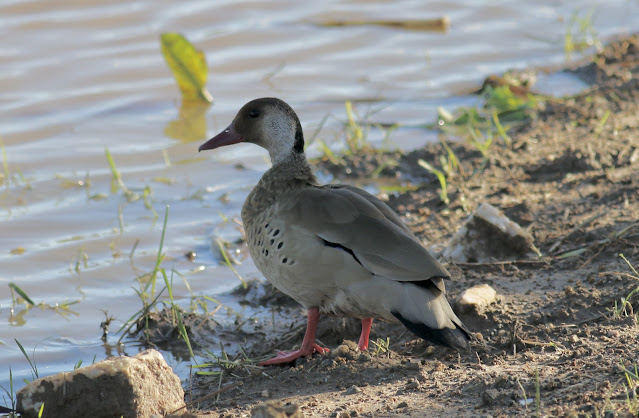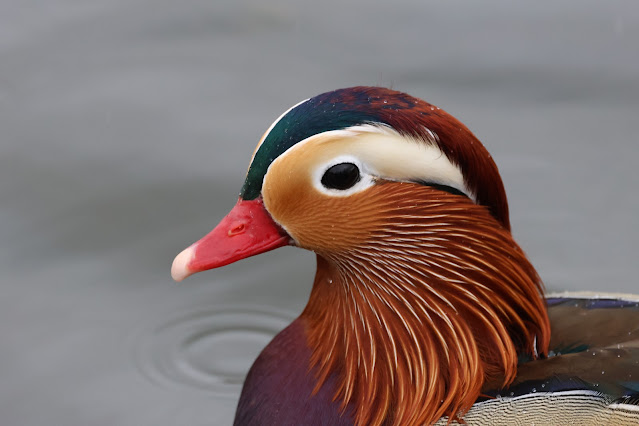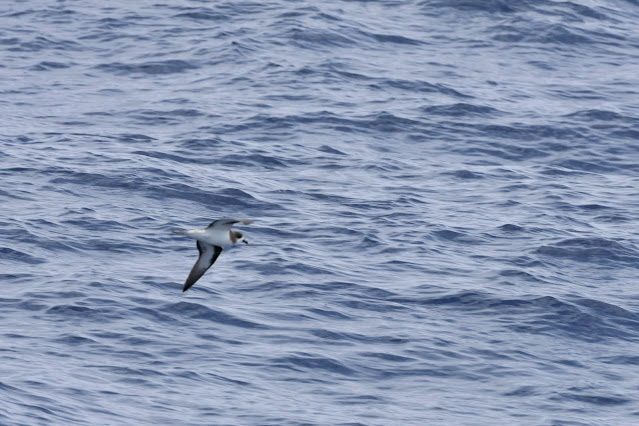This European version of a Canvasback (or Redhead for that matter) is a stunning bird that is clearly easy to get close to in urban parks around the UK. This one was photographed in Hyde Park. The light blue saddle on the bill for males makes it easy to ID.
Monday, June 17, 2024
Sunday, June 16, 2024
American Black Duck (Anas rebripes) - 04Jan2021 & 11Nov2023 & 14Dec2016
Here is one from Wilmington that flushed when I got too close. You can see the speculum feathers lack the white edging of Mallards or Mottled Ducks.
Here are a few that I photographed in flight at Miles Pond in Gloucester Massachusetts.
Eurasian Wigeon (Mareca penelope) - 29Jan2014 & 21Mar2014 & 29Dec2023
This species is migratory and although the breeding range is in Eurasia, it can be found all over including Africa, India and the US. The first photo I have is from a pond in Arizona.
This one was in London in their natural range, but this one has clipped wings! So it is a non-countable one in one of the London parks.
Here is one that showed up in my home county in Wilmington!
Brazilian Teal (Amazonetta brasiliensis) - 10Aug2022
Brazilian Teals are actually more closely related to the Crested Duck of Patagonia than they are to teals but for some reason they are still lumped closely to teals in the taxonomic sequence. I have only seen one so far, at Pousada Aguape in the southern Pantanal region of Brazil. Here it is stretching its wing and showing off the colorful wing panels. It is the only one in the Amazonetta genus.
Mandarin Duck (Aix galericulata) - 20Mar2023 & 14Apr2017
These amazing ducks are obviously Asian in origin but have established populations in various places globally including the UK where my first photos are from (London). Interestingly Wikipedia also lists the feral population in Black Mountain, NC but those are not countable as far as I know. I took the last picture in Asheville, NC. The Aix genus includes Wood Ducks which are the closest living relative to Mandarin Ducks.

Crested Duck (Lophonetta specularioides) - 28Feb2022
Another one of the cool duck species Matt and I picked up in Ushuaia while waiting for our return flight from our Antarctica trip. These are found throughout Patagonia and Terra Del Fuego. The genus is monotypic, meaning this is the only species in it.
Egyptian Goose (Alopochen aegyptiaca) - 20Mar2023 & 05Nov2023
Kelp Goose (Chloephaga hybrida) - 28Feb2024
The Kelp Goose is also in the Chloephaga genus which means grass eating in Latin. However, whereas the Upland Goose will go far inland in south Argentina, Chile and the Falklands, the Kelp Goose sticks to the coast in the same range. As you can tell from its common name, it eats seaweed instead of grass. I suppose seaweed is technically an aquatic grass so the Latin name for the genus still works. We saw this species on our way out of the Beagle Channel in Terra Del Fuego but then got much better looks when Matt and I absconded from the Ushuaia hotel we were supposed to wait in for our flight home. We were supposed to stay in the hotel due to COVID restrictions, but that was intended to protect the locals from tourists entering businesses. Matt and I were only interested in the great outdoors and birds.
This goose rivals the Ross's Goose for the cutest goose in the world.
Upland Goose (Chloephaga picta) - 18Feb2022
It's always good to bag a lifer on your Birthday! These Upland Geese were seen in Terra Del Fuego in Argentina directly before boarding the boat that took me to Antarctica. They look and act like true geese but are more closely related to ducks and specifically shelducks. The first two photos were taken from the bus that took us to our boat. The next couple pics were taken from the boat! This species can be found in far south Argentina, Chile and the Falklands.

Black Swan (Cygnus atratus) - 20Mar2023
Black Swans are the Australian anti-hero to the Mute Swan. They are found throughout Australia and have been introduced in many countries including the UK where I photographed this one. Although they are not currently considered "countable" in the UK, they might be on the cusp of changing that as the birds there are certainly breeding and could be established soon. We have had a few turn up on retention ponds in North Carolina but they were probably escaped aviary birds. I hope to see this beauty soon in its natural range.
Saturday, June 15, 2024
Mute Swan (Cygnus olor) - 21Mar2023 & 06Apr2020
Everyone knows the Mute Swan! Its natural range is in Eurasia but it has been heavily introduced in North America with much controversy. Here is one from the UK where they are "countable".
In North Carolina it depends who you talk to when considering countability. Some say that the ones seen on Pea Island on the OBX are. I happened to see one in 2020 that was floating in the ocean off of Johnnie Mercer Pier. I like to think a "domesticated" swan would never do that.
Friday, June 14, 2024
Fulvous Whistling-Duck (Dendrocygna bicolor) - 07April2024
I was tickled pink to finally get decent photos of my nemesis bird the Fulvous Whistling-Duck on my 2024 trip to the Lower Rio Grande Valley. I was on my way north to visit the Edwards Plateau and randomly decided to stop at Choke Canyon State Park south of San Antonio. Although this species can be found in a wide distribution including Africa, South America and India, they can only be found in limited areas in the USA including Florida and Texas. There are some historical records in North Carolina but I didn't see those. I did see some at a long distance in Cuba but these were much more confiding.
Southern Screamer (Chauna torquata) - 19Aug2022
Undulated Tinamou (Crypturellas undulatus) - 12Aug2022
The first part of the Latin name translates to "small hidden tailed" and the second part means "wave-like markings". Sometimes the latin names do make sense. I have four Tinamou species on my life list but so far this is the only species I have seen much less photographed! We actually saw several on my trip to the Pantanal and surrounding areas in Brazil. This one was trained to come in to seed. It was quite shy and we were instructed to stand stock still before it would finally come out into the open. Tinamous have very loud and their haunting songs travel very far so its easy to add heard-only birds to your list but good luck in seeing them.
Greater Rhea (Rhea americana) - 13Aug2022
The Greater Rhea is the largest bird in the Americas. I saw this one in Aquadauana in the state of Mato Grosso do Sol in Brazil.
Greater Rheas were named after the Greek Goddess Rhea, who knows why.
Although their natural range is only in South America, there is a feral population in Germany that has established itself with over 100 birds that are completely wild!
Thursday, June 13, 2024
Bermuda Petrel!! (20April through 07Jun2024)
I have been on loads of Hatteras pelagics over the years and Bermuda Petrel is probably my biggest pelagic nemesis along with White-faced Storm-Petrel. So needless to say that was the target I had in mind when I scheduled myself for an end of May pelagic trip out of Hatteras. But before I get to that, here are some other random photos from before that trip.
Prothonotary Warblers are always the first neotropical migrant we see in good numbers down here in coastal North Carolina and we couldn't have picked a better one! What an amazing bird with it's crazy yellow hues and large bill, not to mention the neat white under tail coverts. It is altogether a very handsome bird. This one was on Lee Buck Rd in Brunswick county which is still one of the better breeding warbler spots near me.
Red-eyed Vireos are usually not as confiding being heard more often than seen.
My boys finished another track season, and once again Hoggard won the regional/county championships title. George improved his mile time to within 1 second of Luke's best with a time of 4:22!
In May, I led a local Audubon chapter bird walk at Fort Fisher along the Basin Trail.
We had most of the usual suspects including this Painted Bunting.
During all the reports of sun storm activity allowing for amazing views of Northern Lights, I pulled the trigger one day too late when I decided to head out in the middle of Holly Shelter Gamelands to try and see them.
Nothing was visible to the naked eye but I had a handful of Whip-poor-wills calling the whole time I was there.
With my iPhone I was able to pick up some of the lights, but it was a little underwhelming. This photo was taken at 10:30 pm so what you see here is definitely not any lingering sunset.
Great Blue Skimmer - of course as things heat up on the coast, the focus will eventually shift to Odes and Butterflies.
I forget what this picture was for, but as you can see I am blessed with a good looking family!
May 18 was the day of the fateful pelagic. There was a line of boats heading out to sea this day because of a fishing tourney.
Band-rumped Storm-Petrel - We had good activity early on with Storm-Petrels.
Another view of a Band-rumped.
Black-capped Petrel
Sooty Shearwater
Sooties are one of the most confiding of the Shearwaters often coming close to the wake of the boat.
They look so friendly! Almost like they are smiling.
A darker morph of the Black-capped.
Sooty
A Borealis Cory's Shearwater - note the extensively dark primary tips.
Black-capped
Leach's Storm-Petrel - note the notched tail.
Cuvier's Beaked Whale! These bad boys/girls can dive up to 3 hours and 45 minutes! They have gone almost 3 thousands meters deep! The deepest of all the whales or cetaceans.
I failed to get a decent pic of the mouth with the eruptive teeth that stick out that males use for fighting but I thin that's where these marks come from on the back of this one.
"BERDUMA PETREL!!" Kate shouted while I was standing next to her.
First off, let me set the scene. Here is some text from Wikipedia:
The Bermuda petrel (Pterodroma cahow) is a gadfly petrel. Commonly known in Bermuda as the cahow, a name derived from its eerie cries, this nocturnal ground-nesting seabird is the national bird of Bermuda and can be found pictured on Bermudian currency. The Bermuda petrel is the second rarest seabird on the planet. They have medium-sized body and long wings, a greyish-black crown and collar, dark grey upper-wings and tail, white upper-tail coverts and white under-wings edged with black, and the underparts are completely white.
For 300 years, it was thought to be extinct. The dramatic rediscovery in 1951 of eighteen nesting pairs made this a "Lazarus species", that is, a species found to be alive after having been considered extinct. This has inspired a book and two documentary films. A national programme to preserve the bird and restore the species has helped increase its numbers, but scientists are still working to enlarge its nesting habitat on the restored Nonsuch Island.
So if you want to see one you really have to go to Bermuda or you can try your luck on one of Patteson's Pelagics. I have been out on something like 30 pelagics and never seen one. Usually they only get one every other year.
Unfortunately I had the wrong camera settings on when this bird showed up, specifically I had it on spot focus and most of my photos are sub-optimal compared to some of the amazing images others obtained.
When you see one in person, the concerns you have about ID problems seem to fade away. I supposed it just gives a different feeling and you immediately know you have something special.
Probably my best shot.
I won't make that mistake again, now I know to have my settings better set on pelagics as you typically don't get second chances.
I am still on a high from this sighting from over 2 weeks ago!
On the way back into Hatteras we happened upon some phalaropes.

Red-necked Phalaropes
I was completely exhausted from being out in the sun and wind so I decided to spend the night. In the morning I did some birding at Cape Point and the surrounding area.
Bonaparte's Gull - this late bird made me do a double-take.
Ruddy Turnstone at the Old Coast Guard Station.
A fully decked out Common Loon!
Later the next week I went up to Raleigh to treat Melissa to a stay at the Umstead Hotel and Spa. On the way home we stopped at Mal Plantation Rd for a walk on the Neuse River Greenway.
Cliff Swallows nest under the bridge and feed in the fields next to the river.
Indigo Buntings never get old!
Cliff Swallow peeking out from the nest.
Back at home I have been birding sparingly but I did get out to Fort Fisher once or twice.
Cabbage White Butterfly
Brown-headed Cowbird
Luke has graduated High School! He is set to attend UNC Chapel Hill in August, I will miss him being around the house.
I am toying with the idea of finally chasing the Black-whiskered Vireo in Nags Head this weekend so stay tuned.




































































